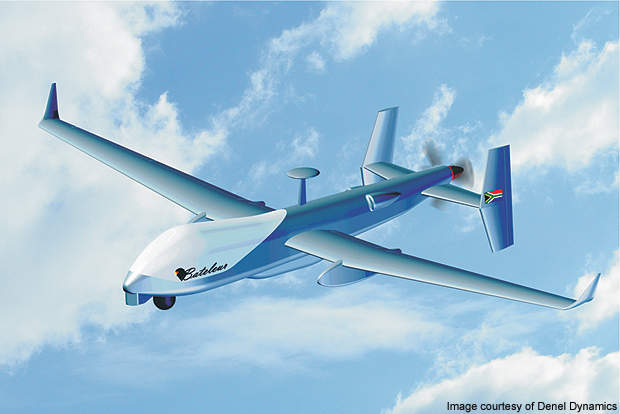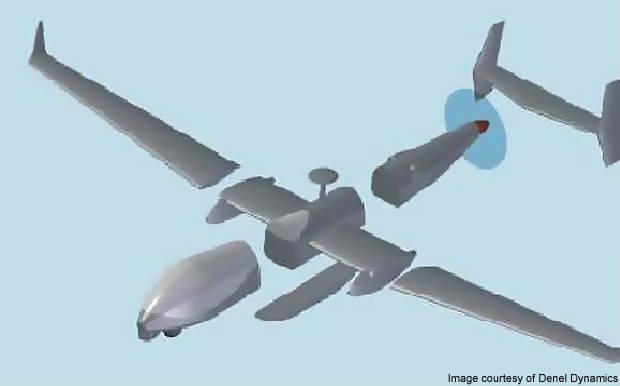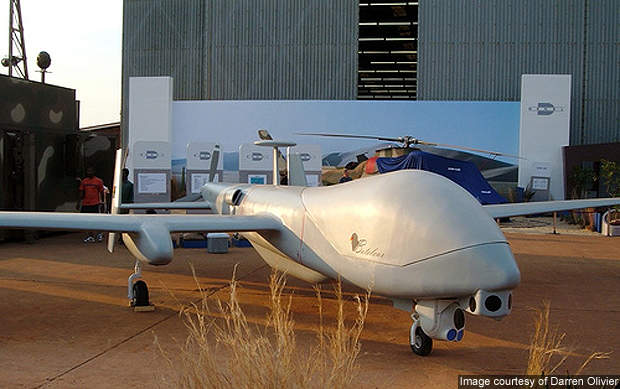
Bateleur is a medium altitude and long endurance (MALE) unmanned aerial vehicle (UAV) being designed and manufactured by the South African company Denel Dynamics, principally to meet the requirements of the South African Air Force (SAAF) and South African Navy (SAN). The maiden flight of the Bateleur, which was scheduled in the first half of 2007, was delayed due to the financial crisis.
The development of Bateleur UAV has been temporarily suspended to focus on the Seeker 400 development.
The UAV will capture real time intelligence data and transmit it to the ground control station through a Ku-band satellite communication data link. Flying at a maximum altitude of 8,000m, the Bateleur will provide its operators with real time intelligence data, performing surveillance and electronic intelligence operations over a large area.
Bateleur UAV design
The Bateleur is being designed to take-off and land automatically on paved runways. It is being designed to be a machine with plug and go elements. The UAV will gather communication intelligence data, assess damage, capture military and paramilitary photos, identify targets and control artillery fire.
The aircraft will also conduct a wide range of missions including maritime, border and coastal patrolling, search and rescue, airborne communications and battlefield surveillance. The Bateleur’s airframe will be constructed with simple modular composite materials.
Bateleur development
The development of Bateleur MALE UAV began in April 2004 as a private venture project with funds generated internally. The name Bateleur is derived from a short-tailed African eagle. The development programme was officially unveiled by Denel Dynamics in September 2004 during the African Aerospace and Defence (AAD2004) exhibition held at Waterkloof air force base. The UAV’s design was completed with wind tunnel testing on a 10% scale model completed during 2005.
The Bateleur was first showcased in November 2005 during the Dubai International Air Show. SAAF unveiled the Itambo project in 2008 to acquire a MALE UAV during 2008-2012 with first priority given to the Bateleur UAV.
The South African National Defence Force (SANDF) discussed with Denel in 2006 to reduce the cost of the system before an acquisition could be considered.
The request for proposal was submitted by the Brazilian Air Force for Bateleur UAV in 2009.
Navigation
The Bateleur UAV can be controlled either manually from the ground control station or through autonomous mode. It can take-off, execute operations and land safely with out any human intervention.
Sensors
The Bateleur will be equipped with Denel Optronics Argos-410 electro-optic (EO) and infra-red sensors or Goshawk-350 EO and Infra-red sensors, laser range finder and electronic intelligence (ELINT) sensors. The EO sensors will convert light rays into electronic signals for capturing images, real-time data and videos.
Radars
The UAV will be fitted with synthetic aperture radar (SAR), signal intelligence (SIGINT), laser designator, and COMINT (communication intelligence) and maritime surveillance radar. The laser designator will be used to locate or identify laser guided bombs, missiles or precision artillery munitions.
Engine
The Bateleur will be powered by a single Rotax 914 or Subaru EA-82T four cylinder engine with three-bladed variable pitch propeller. Each engine can produce 84.5kW of output power. The Rotax 914 is a liquid and air-cooled engine fitted with a separate oil tank, two carburettors, electronic dual ignition, electric starter, propeller speed reduction unit and air intake system.
Ground Control Station (GCS)
The Bateleur ground control station will be similar to that of the Seeker II for executing long range missions. The GCS will process, retrieve and store the real time information offered by the Bateleur.
The GCS will be manufactured by Denel Dynamics and can control the UAV as well as its payloads. It will be equipped with a mission control unit (MCU), and tracking and communication unit (TCU).
The MCU will serve as the communicator between mission control crew and the Bateleur.
The TCU will be used for communicating with the UAV. The tracking and communication payload incorporated in the aircraft will keep track of the Bateleur. The TCU will be a separate unit positioned 80m away from the MCU to provide maximum line of sight (LOS) communication.
Performance
The Bateleur can fly at a maximum speed of 250km/h. Its stall speed is 120km/h. The range of the aircraft will be 750km. The Ku-band incorporated in the aircraft will increase the range of the aircraft to 3,500km allowing it to operate long-distance missions.
The take-off distance of the aircraft will be 395m. Its maximum endurance will vary between 18 and 24 hours. The aircraft will weigh around 200kg and its maximum take-off weight will be 1,000kg.
The Global Unmanned Aerial Vehicles (UAV) Market 2011-2021
This project forms part of our recent analysis and forecasts of the global Unmanned Aerial Vehicles (UAV) market available from our business information platform Strategic Defence Intelligence. For more information click here or contact us: EMEA: +44 20 7936 6783; Americas: +1 415 439 4914; Asia Pacific: +61 2 9947 9709 or via email.






